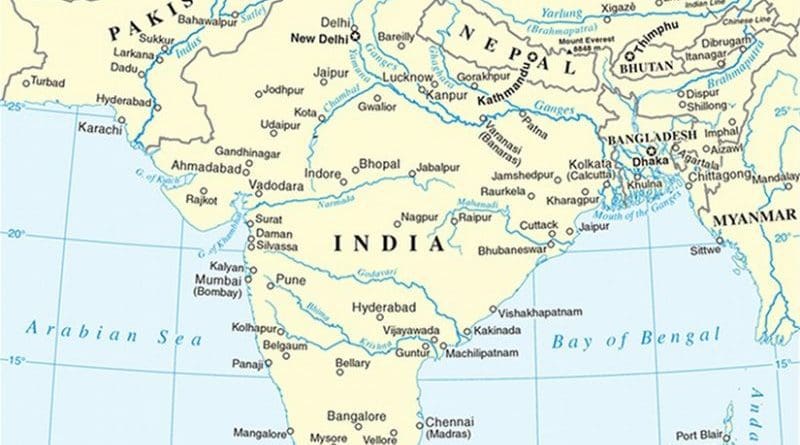Indian Ocean: Re-Energising Trade Integration In IORA – Analysis
By RSIS
The recent inaugural Indian Ocean Conference (IOC 2016) while well-timed and successful in projecting India’s soft power, failed to come up with concrete recommendations to re-energise trade within the region. This should be a key focus of IOC 2017.
By Pradumna B. Rana*
The recent India-led inaugural Indian Ocean Conference (IOC 2016) held in Singapore on 1-2 September was well-timed – just when mistrust of China has increased in the region because of its actions in the South China Sea. It was also successful in projecting India’s soft power in the East Asian region. However, although an entire session was devoted to “commerce” (international trade and investment issues), the Conference failed to come up with concrete recommendations to re-energise trade integration among the 21-member Indian Ocean Rim Association (IORA). This should be a key focus of IOC 2017 to be held in Sri Lanka.
As is well-known, in the bygone era the Indian Ocean was an active thoroughfare of commercial and religious traffic. Subsequently during the colonial period, trade on the Indian Ocean was fragmented. Presently, intra-regional trade among the IORA members is about 25 per cent of their total trade. But a large chunk of this is trade between ASEAN and Australia: Trade among other IORA members is relatively low. How can intra-regional trade among IORA members be re-energised?
From Look East to Act East
India’s Look East Policy (LEP) was initiated by Prime Minister Narasimha Rao in the early 1990s as part of the country’s economic reform package. The objective of the Look East Policy was to promote India’s economic linkages with the 10-member ASEAN. The policy was successful. India’s trade with ASEAN has surged and the country participates actively in various fora initiated by ASEAN such as the ASEAN Regional Forum, and the East Asia Summit. India also holds summit-level dialogues with ASEAN.
In 2014, Prime Minister Narendra Modi upgraded the LEP to the Act East Policy amidst much fanfare. The Act East Policy has the strategic dimensions which the LEP did not have. Also the coverage of the Act East Policy is broader as it covers not only ASEAN but also Korea, Japan, Australia and the Pacific Island countries. But what more? If an answer cannot be provided, then the move from Look East to Act East could simply mean a change in nomenclature, nothing more.
At the IOC 2016, India’s Foreign Secretary, Mr S. Jaishankar, emphasised that “For the Indian Ocean to attain its true potential, it is imperative that India which is the centre of gravity, should be a facilitator rather than an obstruction. That requires a smoother movement of goods and people within India but also to its immediate neighborhood and beyond”.
What should be the components of India’s Act East Policy and what type of trade policies should India’s neighbouring IORA members in South Asia, the Gulf region and Africa adopt in order to re-energise trade integration in IORA? The findings of my on-going research provide some answers.
Paradigms of Trade
Under the traditional theory of trade, developing countries produced labour intensive goods which they then exchanged for relatively capital and skill intensive goods produced by the more advanced countries. All separate tasks involved in producing a good were done entirely at home. But now the way many goods are produced and traded around the world is no longer the same as before.
Production is sliced and diced into separate fragments and production of parts and components are spread around the world linked together as production networks or supply-chains. Nike is a well-known example of this phenomenon. While research and design of shoes remain in the United States, most of Nike’s production is in developing countries. Nike relies on production facilities in around 50 countries mostly in Asia and Latin America.
East Asia is dense with production networks. It is estimated that East Asia accounts for nearly 45 per cent of global production network or supply-chain trade with China and the ASEAN countries in the lead. To benefit from these developments in East Asia, India and its neighbouring IORA members should (i) link themselves to production networks in East Asia; and (ii) develop production networks in manufacturing and services within their own region. Such actions would allow the IORA region to benefit not only from the static complementarities of the traditional trade theories but also the dynamic complementarities associated with the new international trade theory.
Trade Policies in India and Neighboring IORA members
The Act East Policy in India and trade policies in India’s neighbouring IORA members should comprise the following five, sometimes overlapping, components:
- First, these countries need to improve the environment facing the private sector through governance, regulatory, labor market, and legal reforms so that their scores in the World Bank’s Ease of Doing Business Index would increase.
- Second, these countries should improve their information and communications technology (ICT) systems so that supply chains can be coordinated and managed efficiently.
- Third, India and neighbouring IORA members should strive to reduce logistics costs including trade facilitation at the border. With product fragmentation, efficient logistic service is a key determinant of a country’s competitiveness.
- Fourth, these countries should support on-going efforts to enhance physical connectivity within the region as this would reduce trading costs and enhance trade competitiveness. The Trilateral Highway, the Kaladan Project, the Mekong-India Economic Corridor, and the Bangladesh-China-India-Myanmar Economic Corridor projects should be supported. Maritime connectivity within the IORA region should also be improved.
- Finally, a Trans-Indian Ocean Partnership among the IORA members should be established. This would complement the ASEAN-driven Regional Comprehensive Economic Partnership (RCEP) and be the IORA’s answer to the US-led Trans-Pacific Partnership (TPP) and the EU-US led Trans-Atlantic Trade and Investment Partnership (TTIP).
*Pradumna B. Rana is Associate Professor and Coordinator of the International Political Economy Programme in the Centre for Multilateralism Studies (CMS) at the S. Rajaratnam School of International Studies (RSIS), Nanyang Technological University, Singapore.

